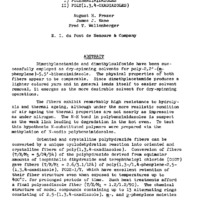Aromatic Polymers for Thermally Fibers and Films I) Polybenzimidazoles II) Poly(1,3,4-Oxadiazoles)
Item
- Title
- Aromatic Polymers for Thermally Fibers and Films I) Polybenzimidazoles II) Poly(1,3,4-Oxadiazoles)
- Date
- 1963
- Date Issued
- 1963-01
- Publisher
- Wright-Patterson Air Force Base, OH : Directorate of Materials & Processes, Aeronautical Systems Division, Air Force Systems Command
- DoD Project
- 7320 - Fibrous Materials for Decelerators and Structures
- DoD Task
- None Given
- Laboratory
- Directorate of Materials & Processes
- Distribution Conflict
- No
- Distribution Classification
- 1
- Abstract
-
Dimethylacetamide and dimethylsulfoxide have been successfully employed as dry-spinning solvents for poly-2,2'-(m-phenylene)-5,5'-bibenzimidazole. The physical properties of both fibers appear to be comparable. Since dimethylacetamide produces a lighter colored yarn and in general lends itself to easier solvent removal, it emerges as the more desirable solvent for dry-spinning operations.
The fibers exhibit remarkably high resistance to hydrolysis and thermal ageing, although under the more realistic condition of air ageing the thermal properties are not nearly as impressive as under nitrogen. The N-H bond in polybenzimidazoles is suspect as the weak link leading to degradation in the hot oven. To test this hypothesis N-substituted polymers were prepared via the methylation of N-sodio polybenzimidazoles.
Oriented and crystalline polyhydrazide fibers can be converted by a unique cyclodehydration reaction into oriented and crystalline fibers of poly(1,3,4-oxadiazoles). Conversion of fibers (T/E/Mi = 5/24/94) of the polyhydrazide derived from equimolar amounts of isophthalic dihydrazide and terephthaloyl chloride (OIOT) gave fibers (T/E/Mi = 2.6/3.1/124) of poly(1,3-/1,4-phenylene-2,5-(1,3,4-oxadiazole), PODZ-I/T, which have excellent retention of their fiber structure even when exposed to temperatures up to 400°C. for prolonged periods of time. Such heat treatments afford a final polyoxadiazole fiber (T/E/Mi = 1.2/1.2/90). The chemical structure of model compounds containing up to 13 alternating rings consisting of 2,5-(1,3,4-oxadiazole), m- and p-phenylene moieties was found to be stable up to 400-450°C. This is in agreement with observed stabilities of the corresponding polymer towards thermal degradation. - Index Abstract
- Contrails only
- Identifier
- AD0299030
- DTIC Record Exists
- No
- Report Availability
- Full text available
- Creator
- Frazer, August H.
- Wallenberger, Fred T.
- Kane, James J.
- Extent
- 40
- Corporate Author
- E. I. du Pont de Nemours & Company
- Report Number
- ASD TDR 62-964, p. 57-95
- Provenance
- Lockheed Martin Missiles & Fire Control
- Type
- article
- Relation
- This paper was presented at the Directorate of Materials and Processes "Symposium on Fibrous Materials" held in Dayton, Ohio, on 16-17 October 1962
- Format
- 1 online resource (40 pages)
- Is Part Of
- Symposium on Fibrous Materials
- Media
 ASDTRD62-964paper04.pdf
ASDTRD62-964paper04.pdf
Linked resources
Warning: Undefined array key "id_concat" in /var/www/html/omeka-s/themes/foundation/view/common/linked-resources.phtml on line 40
Warning: Undefined array key "property_alternate_label" in /var/www/html/omeka-s/themes/foundation/view/common/linked-resources.phtml on line 41
Warning: Undefined array key "property_label" in /var/www/html/omeka-s/themes/foundation/view/common/linked-resources.phtml on line 43
| Title | Class |
|---|---|
| Symposium on Fibrous Materials |